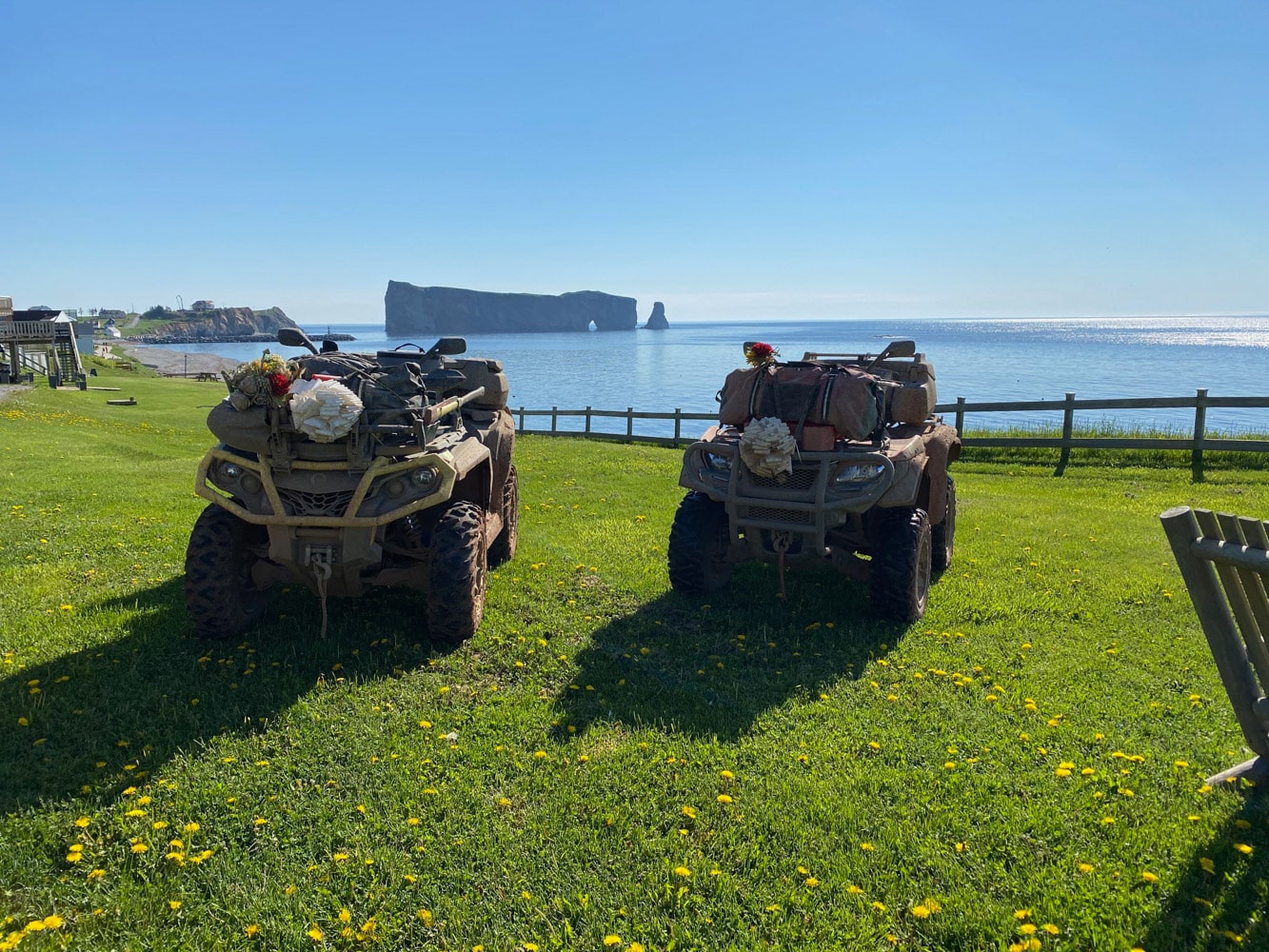Very soon, and for the fourth time, I will be participating in a tour of the Gaspésie with a group of quad riders. As a participant, I don’t have to worry about the route, the accommodations, the refreshments, the detours and the planning of all kinds, which makes my job much easier. On the other hand, I have to be well prepared to take full advantage of this ride that many quad riders dream of. With the personal experience but also that of other participants, I have greatly improved the organization of the luggage, the configuration and the equipment that I carry on my quad.
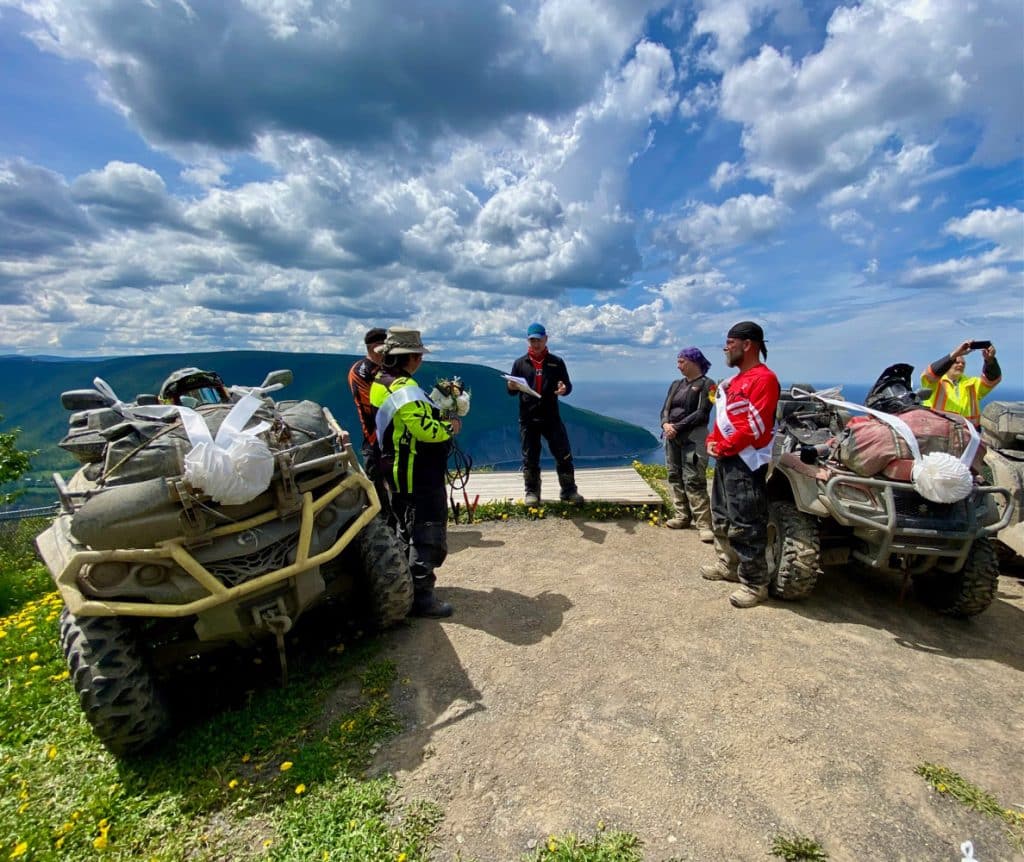
My wedding at the top of Mount Saint-Pierre during the 2022 hike
The machine
The tour of the Gaspé Peninsula is 1400 kilometers of trail in seven days, which is more kilometers than most ATV riders do in a year. We will encounter very steep climbs, very steep descents, mud, rocks, flinty pebbles, rain and possibly snow. No matter how much people say that a quad is made for that, it is a tough test for our machines. Without being a mechanic, I do the basic maintenance myself and especially an inspection in preparation for the trip. If I discover a problem or if I have a doubt, I consult my dealer.
- Washing to allow visual inspection
- Visual inspection of tires, suspension, seals, brake pads, universal joint boots, radiator and components, front and rear lights
- Verification of all oil and antifreeze levels
- Change engine oil
- Lubrication
- Wash the air filter
- Checking the winch
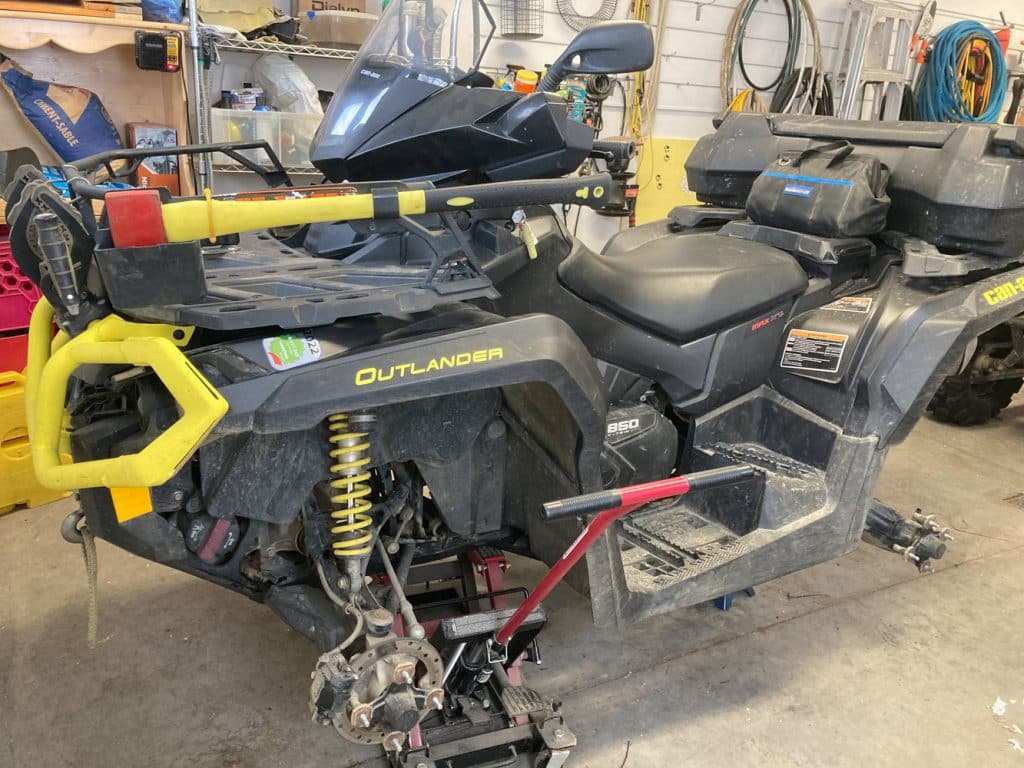
My vehicle during its preparation
Troubleshooting kit
Although the tour organizers are very well equipped with repair tools, every participant should be able to do some minor repairs. Especially flat tire repairs! Each year, the number of flat tires in the group varies from 12 to 26 and my personal record is 3. I have a particular memory of one year when an autoquad tore the sidewall of a tire in a narrow passage of a rocky trail on a steep slope. It was beyond repair. Despite this, the entire group rallied to perform a tire change worthy of an F1 pit stop. The carquad was lifted on its side by force of arms, an electric “impact” appeared from nowhere to remove the tire while another one kindly lent by a participant was carried from hand to hand to the broken vehicle. Five minutes later the whole group was on its way.
The mutual aid between quad riders is generous and you don’t stay broken down alone for very long. However, each vehicle should have its own breakdown kit containing :
- Two packs of wicks (preferably red ones)
- A puncture repair kit (drilling tool, wick holding tool, soapy water)
- A compressor
- A spare belt
- Tools required to change the belt
- Pliers, screwdriver, wrenches
- Flashlight
- Towing belt
- Various fuses
- Electrical tape, Duck Tape, tie-wraps
- -All the things we would have liked to have during a breakdown, time will take care of making the list…
- 🙂
On a hike such as the Tour de la Gaspésie, the group should have a chainsaw, a remote first aid kit, a satellite phone and contact information for clubs visited along the way.
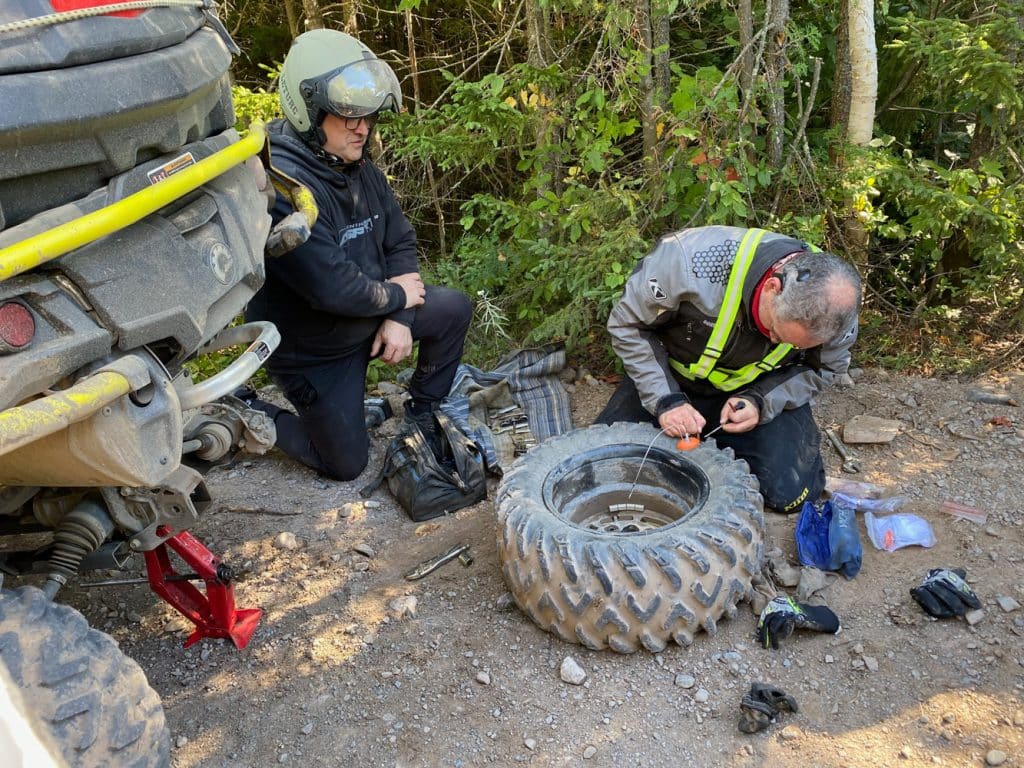
A repair on the trail
Luggage
Will it be hot, will it be cold or Will it rain? YES!
Packing for a seven-day ride may seem easy, but you still have to be able to carry it on your quad. I am reminded of another vivid memory that describes the situation well. While we were in line to pay for our gas, the man in front of us pulled out his bright pink wallet and said with a laugh: With two people on a quad, you have to make choices. It was very funny. Indeed, carrying two people’s luggage for seven days on a quad bike can present some interesting challenges. This is not so much the case with an autoquad or for a single person on his machine like me.
During the tour of the Gaspé Peninsula, the temperature can vary brutally in a few minutes, for example when passing the Chic-Chocs mountains. I have seen a 20 degrees variation between the temperature in the valley and the one at the top. Even in June, we can still see snow, sometimes enough to throw a few snowballs, other times enough to get stuck.
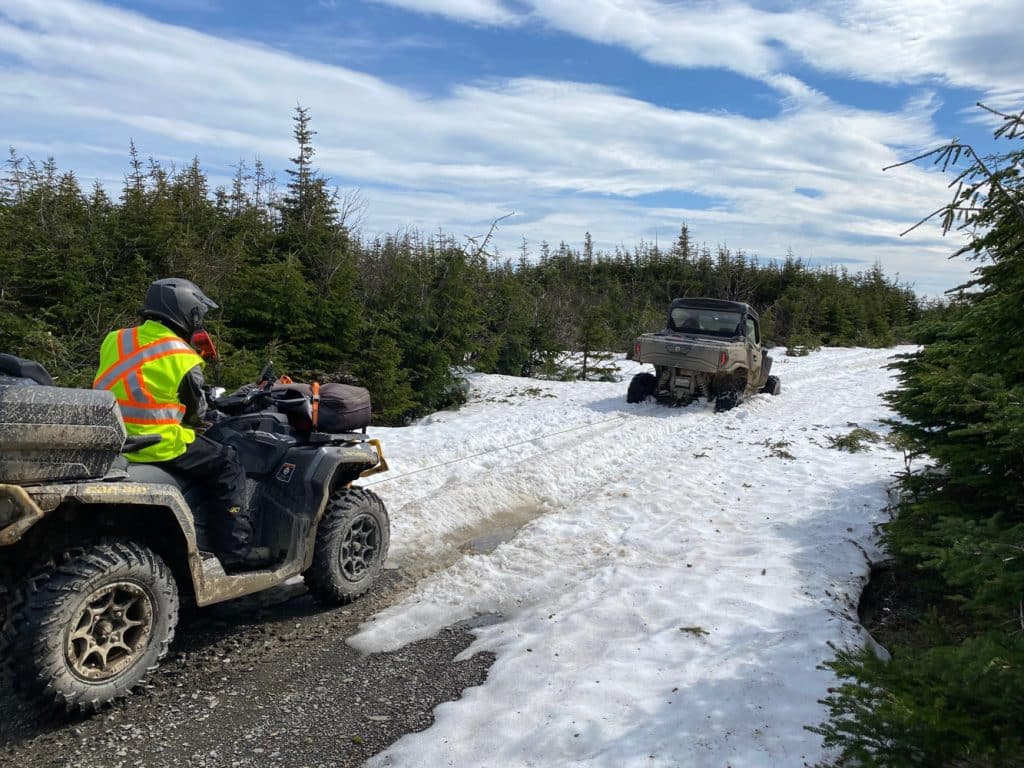
The clothing
Following the temperature variation along the day, or facing a small rain shower, it is normal to adjust one’s clothes in order to stay comfortable. So I divide my luggage in two categories, what I might have to wear during the ride and the rest. The first one will be in my backpack, easy to access, and does not require a waterproof bag. The other one will be firmly attached to the front of my quad and will be subject to all the bad weather of the road: rain, dust, mud or snow.
We keep within reach :
- Warm gloves, protective gloves and cycling gloves
- Bandanas, sunglasses
- A rain kit
- Various under-layers from fleece to t-shirt
- A kit for trail stops (cap, sunscreen, fly repellent)
- A cooler for lunches on the trail
- …
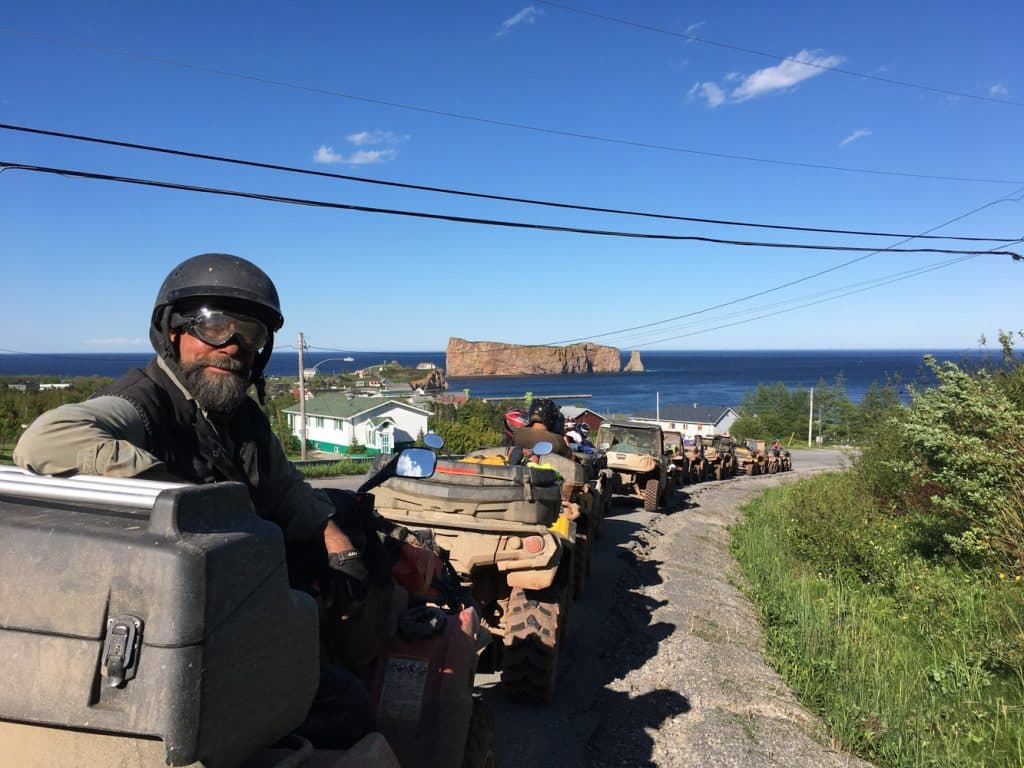
Spectacular arrival in Percé
I’m often asked what clothes I wear while hiking. I am fortunate to have clothing with a Gore-Tex membrane, a material that is both breathable and waterproof. My jacket is very versatile and I wear it from 0 to 25 degrees, in the sun or in the rain, by adjusting the layers of clothing and the ventilation openings. My pants have the same qualities and protect me from the heat of my engine. For footwear, I wear hunting boots also with the Gore-Tex membrane. Equipped like this, I stay dry as a soda cracker even in the worst weather.
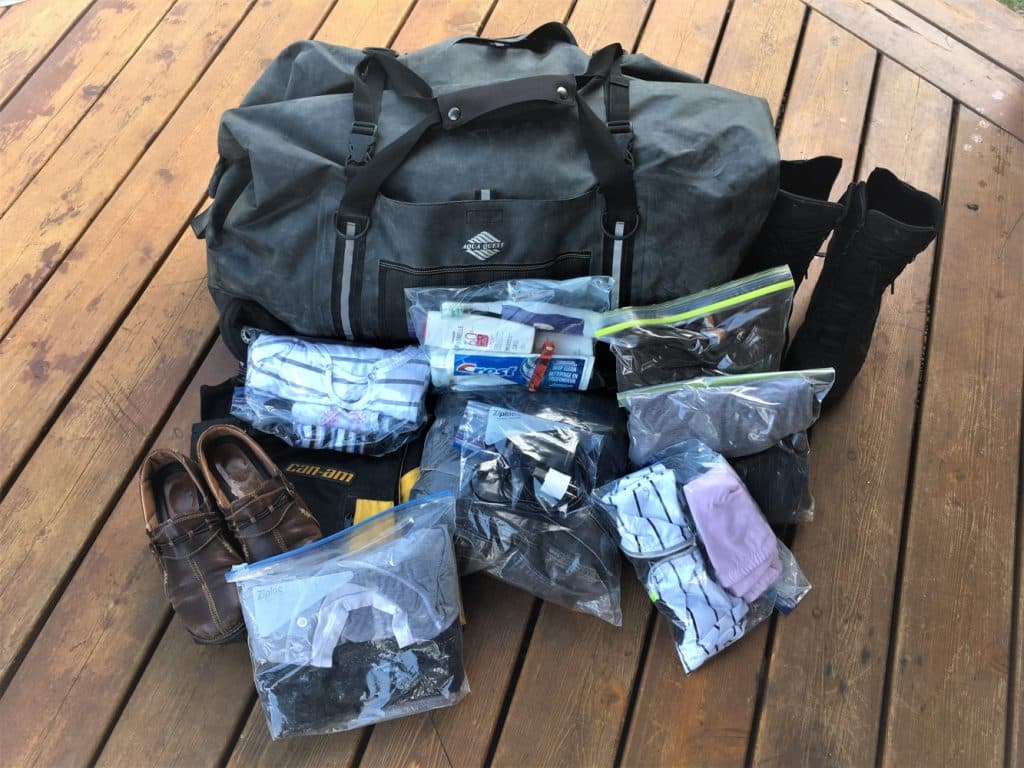
For most ATV riders, the main bag will be subjected to rain, dust, vibration, shock and abrasion. The choice of bag used and the way it is secured to the vehicle will ensure that whatever is inside will be damp in case of rain. Ideally the bag should be waterproof. I insist on waterproof and not water resistant. Some products may be water resistant when left outside in the rain but will quickly get soggy when strapped to the front of a quad bike going 50km/h in the same rain. A quick search with the key words waterproof bag will bring up hundreds of bags of all sizes. The simplest and most effective is the model where you fold the openings of the bag two or three times to ensure waterproofness. I don’t recommend the waterproof zipper because mud and dust will eventually break it.
My bags ready to travel
I personally use a 75 liter waterproof bag with the opening on the widest part of the bag. This feature is important for use to avoid having to empty the bag to reach the bottom.
In my large bag, my belongings are rolled up and placed in Ziploc bags that I squeeze before closing to save space. One for underwear, one for t-shirts, one for shower items, etc. This has several advantages: it keeps your bag from becoming a huge mess, allows you to separate clothes if there are two of you using it, and still keeps your things dry in case your waterproof bag fails. To try it is to adopt it! (I use the brand Ziploc to illustrate the product, any bag of the same nature will do).
Docking
On the trail, the quad gets shaken up and so does the luggage. The rocky trails at good speeds make the suspension work and sometimes a misjudged rock can crush it to the bottom, which makes our wrists feel a little sore. Nevertheless, our luggage should not move too much. Indeed, a waterproof bag is vulnerable to abrasion by friction and to cuts by pinching. It is therefore important to avoid the small continuous vibration of the bag on its support or the crushing of its fabric against a hard part of the quad.
The combination of the ratchet strap and the elastic band is the best I have found so far. The strap holds the luggage in place when the quad is moving hard or wide, while the elastic band controls the small swinging motion. When installing, be careful that no metal part is in direct contact with the waterproof bag. A little tinkering with an old piece of rubber allows for a safe installation of the ratchet strap. Simply cut a strip and make two spaces for the strap to pass through. You can then install it directly on the waterproof bag without fear.
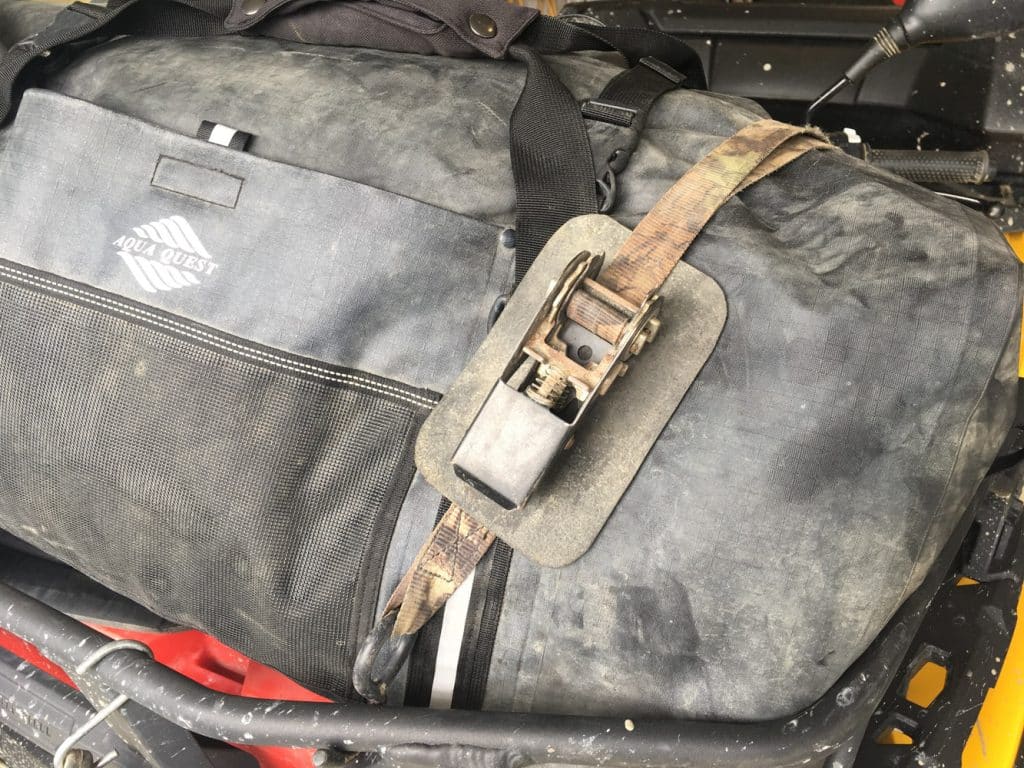
Easy do-it-yourself bag protection
Checking the securing during the trip
Once installed and after a few minutes, the waterproof bag will slowly deflate under the pressure of the strap. It is necessary to tighten it a few kilometers after the start. Experience shows that if you have to lose luggage, it will be in the first five kilometers. One year, right at the start of the tour, an autoquad had not closed its rear trunk properly. As he climbed the first hill, his entire load spilled onto the ground. We followed him and picked up his belongings, which we strapped onto our machines as best we could.
When he saw us coming with his luggage on top of ours, it was really funny.
So, it’s prudent and wise to inspect our stowage a few miles into the trip.

A magnificent viewpoint in Gaspésie
In conclusion
Going around the Gaspé Peninsula on a quad is quite an adventure and I know that I am lucky to be able to make this beautiful trip for the fourth time. At the time of writing, I am in full preparation, I am counting the days. I hope to complete the tour without any major mechanical glitches, with just enough rain, snow and unexpected events. I will see several companions from the last years, because I am not the only one who does the tour repeatedly (75% of the 2023 participants are repeat offenders like me).
For others, it will be a first, they will discover the splendors of Mount Saint-Pierre, the Chic-Chocs, the Percé Rock, Bonaventure and other small pieces of the Gaspé Peninsula. They will experience the joy of repeated flat tires, hot radiators and all the mutual aid and camaraderie that comes with being in a group for seven beautiful days of adventure on the trail.
Text: Chantal Pelletier, Columnist


